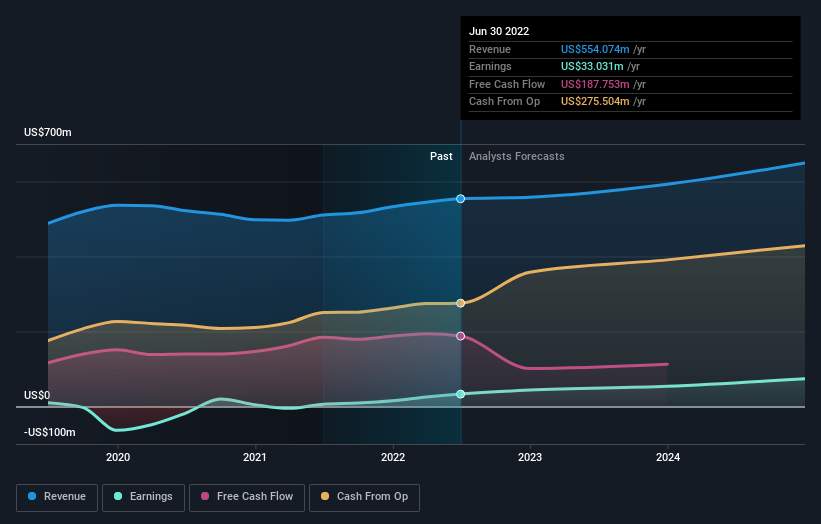Shareholders in Phillips Edison (NASDAQ:PECO) are in the red if they invested a year ago
It's normal to be annoyed when stock you own has a declining share price. But sometimes broader market conditions have more of an impact on prices than the actual business performance. The Phillips Edison & Company, Inc. (NASDAQ:PECO) is down 11% over a year, but the total shareholder return is -7.8% once you include the dividend. And that total return actually beats the market decline of 44%. Because Phillips Edison hasn't been listed for many years, the market is still learning about how the business performs. Unfortunately the last month hasn't been any better, with the share price down 17%. But this could be related to poor market conditions -- stocks are down 17% in the same time.
With that in mind, it's worth seeing if the company's underlying fundamentals have been the driver of long term performance, or if there are some discrepancies.
View our latest analysis for Phillips Edison
We don't think that Phillips Edison's modest trailing twelve month profit has the market's full attention at the moment. We think revenue is probably a better guide. Generally speaking, we'd consider a stock like this alongside loss-making companies, simply because the quantum of the profit is so low. For shareholders to have confidence a company will grow profits significantly, it must grow revenue.
In the last twelve months, Phillips Edison increased its revenue by 8.5%. That's not a very high growth rate considering it doesn't make profits. While the stock is down 11% over the last twelve months, that's not bad in this market. So it looks like shareholders aren't caving in to fear at this time. Shareholders clearly have confidence that profits will come. But you should form your own independent opinion.
The graphic below depicts how earnings and revenue have changed over time (unveil the exact values by clicking on the image).
We know that Phillips Edison has improved its bottom line over the last three years, but what does the future have in store? If you are thinking of buying or selling Phillips Edison stock, you should check out this FREE detailed report on its balance sheet.
What About Dividends?
As well as measuring the share price return, investors should also consider the total shareholder return (TSR). Whereas the share price return only reflects the change in the share price, the TSR includes the value of dividends (assuming they were reinvested) and the benefit of any discounted capital raising or spin-off. So for companies that pay a generous dividend, the TSR is often a lot higher than the share price return. As it happens, Phillips Edison's TSR for the last 1 year was -7.8%, which exceeds the share price return mentioned earlier. This is largely a result of its dividend payments!
A Different Perspective
While they no doubt would have preferred make a profit, at least Phillips Edison shareholders didn't do too badly in the last year. Their loss of 7.8%, including dividends, actually beat the broader market, which lost around 44%. Things weren't so bad until the last three months, when the stock dropped 16%. It's always a worry to see a share price decline like that, but at the same time, it is an unavoidable part of investing. However, this could create an opportunity if the fundamentals remain strong. It's always interesting to track share price performance over the longer term. But to understand Phillips Edison better, we need to consider many other factors. Like risks, for instance. Every company has them, and we've spotted 3 warning signs for Phillips Edison (of which 1 is concerning!) you should know about.
We will like Phillips Edison better if we see some big insider buys. While we wait, check out this free list of growing companies with considerable, recent, insider buying.
Please note, the market returns quoted in this article reflect the market weighted average returns of stocks that currently trade on US exchanges.
Have feedback on this article? Concerned about the content? Get in touch with us directly. Alternatively, email editorial-team (at) simplywallst.com.
This article by Simply Wall St is general in nature. We provide commentary based on historical data and analyst forecasts only using an unbiased methodology and our articles are not intended to be financial advice. It does not constitute a recommendation to buy or sell any stock, and does not take account of your objectives, or your financial situation. We aim to bring you long-term focused analysis driven by fundamental data. Note that our analysis may not factor in the latest price-sensitive company announcements or qualitative material. Simply Wall St has no position in any stocks mentioned.
Join A Paid User Research Session
You’ll receive a US$30 Amazon Gift card for 1 hour of your time while helping us build better investing tools for the individual investors like yourself. Sign up here

 Yahoo Finance
Yahoo Finance 
